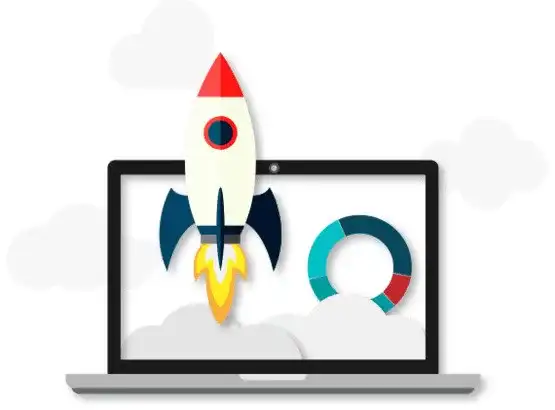Speed Optimization Service
Website Speed Optimization
Optimizing a website’s page speed is essential to create a positive user experience. Pages with longer loading times tend to have higher bounce rates and lower average time on page. Website speed times have also been shown to affect conversions negatively. In plain English, if your company site is too slow, people won’t stick around to sign up or buy products from you.


Why You Should Do Website Speed Optimization
Many digital marketing practitioners view page speed optimization as something they do for search engine optimization. After all, Google has often said that page speed is a ranking factor.
We will send you a complete report of before and after optimization information so that you can easily track the work done and understand the differences. We will optimize your website to leverage your hosting and check your coding to achieve maximum performance. The resulting lower page file size, DNS lookups, and requests from the server, the faster the content is delivered.
Why Is It Important To Have A Fast Website?

More Visitors
Nobody likes a slow website. 43% of users lose their patience and leave a website if it takes more than 3 seconds to load. Having a fast website ensures a good customer experience and increases the chances of users visiting other pages on your site.

Better Ranking
Page load time is a significant search engine ranking factor. A faster website can lead to a higher rank in the search engine results, attracting more potential customers. This means that having an optimized website is a must.

Maximize Profits
Speed matters, and a faster website can help boost conversion rates. A delay of just 0.1 seconds can hurt conversion rates by 7%. Imagine what a 5second improvement in load time will do then. Don’t let your business suffer – speed up your website today.
How We Increase Your Website Loading Speed
Optimize Images
We use lossless compression to optimize all your images without sacrificing quality. We’ll also auto-compress any images you upload in the future.
Render-blocking Resources
We use lossless compression to optimize all your images without sacrificing quality. We’ll also auto-compress any images you upload in the future.
Minify Javascript and CSS
We concentrate all scripts and styles, minify and compress them, add expired headers, cache your website, and move styles to the page head and scripts to the footer.
Leverage Browser Caching
We set up a regularly-updated saved version of your website. When people visit your site, they’re shown a faster-loading cached version instead of having to load the entire website.
Enable Compression
We enable Gzip compression from your server or where your assets are being delivered. This means lower loading times and an overall faster website.
Remove Query Strings
URLs with a “?” are not cached by specific proxy caching servers or CDNS. This could mean a missed opportunity for increased speeds, so we optimize them.
Review Server Response Time
Slow websites can often stem from living on an inadequate server. We will monitor your hosting provider’s resources and recommend changes if needed.
Combine Requests
We reduce the number of requests your website calls out for by combining all your CSS and JS and moving what we can to the footer, which can help lower load times.
Inline Critical CSS
CSS is technically only supposed to be declared in the header, so we outline the most critical CSS and load what’s unnecessary after it has rendered the page.
Lazy Loading Images
Lazy loading for iframes and images across your site decreases load time and saves bandwidth. We make sure not to use external JS libraries to keep the call-outs minimum.
Frequently Asked Questions
We have listed everything for our customers. Still, if you find any doubt, you can connect with us via Email or Social Media Network. Here are answers to some Frequently Asked Questions.
The speed of your website is an important trust factor with both visitors and also the search engines. If you want to offer your visitors the best experience and capture their attention – you need to have a website that loads quickly. From a search engine perspective, a faster website can help your website to be more visible in the search results.
We weren’t happy with the speed test tools on the market so we built our own!
In the past we used Pingdom and GTMetrix and while they’re both good tools, they had huge gaps in their recommendations. GTMetrix servers can bequite slow and report slower load times that they should.
We also use Google Pagespeed Insights or Google Lighthouse.
Typically we focus on improving Core Web Vitals metrics and related speed timings.
Ideally we want our speed timings looking something like this:
-TTFB 0.1-0.2 seconds (this is where is should be in the country where the site is hosted, 0.2-0.5 internationally)
-FCP at or under 1.5 second
-LCP under 2.5 seconds but ideally as close to the LCP as possible, generally within 1 second of the LCP is fast
-load time 1.5-3 seconds
-fully loaded time can vary a lot depending on the third party code being used. Generally we’d expect to see it 1-2 second higher than the load time but this largely depends on the type of site, eg with a Woocommerce site this could easily be 3-5 seconds higher depending on the marketing code in use
We typically need around 2-4 working days to optimize your website’s speed from the point of receiving your order. From time to time this may be a little longer, as it will depend on our current work schedule. Once the Speed Optimization work is complete, we will send over our report, including details of the work completed.
We have over 150 steps in our process so it’s impractical to give you finite detail on everything we do.
If you have a large site that’s mission critical we recommend you look at the Consult Service. With this service we audit the site to start with, create a detailed action plan and then work with you on the implementation of the plan. This service provides the most detail on changes we make.
Generally the first step in our process is to identify the key problems that are slowing your site down, fix them and then work on general best practices. We’ll explain what these problems are and give you an explanation of why they’re problematic as well as provide before and after speed reports.
More broadly, here are the things we do:
WordPress Best Practices Review & Optimization
Most sites we work on have configuration errors or problems simply because the sites have been worked on by several people over time. We review your entire site and hosting configuration and ensure it’s configured in a best practices fashion.
Browser & Page Caching Configuration & Tuning
Caching is one of biggest improvements you can make to your WordPress site speed. Caching setup is a lot more complex than simply installing a caching plugin and turning everything on.
Each site is different and as such caching needs to be customized specifically to each site. On top of that, often caching settings are counter intuitive and on some hosts turning on things like Database Caching will actually slow your site down.
You’ll also find that many of the improvements that speed test tools on the web recommend such as removing query strings from static elements can actually create problems.
Database Optimization & Cleanup
If your site has been around for a while there may be garbage in the database that is slowing it down. For example, expired transients on Woocommerce sites can be a huge problem as well as using the older MyISAM storage engine for database tables.
As part of our service we cleanup and optimize your database to ensure it’s running as fast as possible.
Redis or Memcached Object Cache setup (where possible)
Object caching is a type of database caching that speeds up areas such as the WordPress backend, Woocommerce checkout and generally anything in WordPress that relies heavily on CPU or database lookups. Not all hosts support object caching but where possible we’ll get either Memcached or Redis installed and configure Object Caching.
Edge Caching setup using Cloudflare
Edge caching is a type of page caching where the site or pages are cached on CDN edge nodes. This significantly reduces the load on your hosting and largely eliminates the impact of geography on your site speed. We strongly recommend all compatible sites use the Cloudflare APO Edge Caching service. It’s $5/USD month (purchased from Cloudflare) but makes a significant impact on site speed.
HTAccess File Optimization
HTAccess is one of your web server’s key configuration files and it often contains code that is slowing you down or causing problems in some way. We review your HTAccess configuration and ensure that it’s configured in a best practices format.
404 & Bad Request Review & Repair
It’s not unusual to find spelling errors in code or some other issue that is causing images or break or bad requests to your server. We review all elements that you site loads to ensure they’re not timing out or resulting in a 404 error.
Plugin Review & Pruning
Duplicated and outdated plugins are a huge problem when it comes to WordPress speed. Often this is something as simple as having multiple SEO plugins installed which is bad for both speed AND your Google rankings.
We review all your plugin to make sure they’re actually all required or being used, that none are providing duplicate functionality or causing conflicts somewhere in your site.
Server Compression Tuning
Many website servers don’t have compression turned on by default. We make sure your server compression settings are tuned for maximum performance.
Before and After Reports
We all the work we do we take before and after speed snapshots so we can show you exactly what improvements to site speed have been achieved.
Image Optimization & Compression and NextGen Image Optimization
Images are usually the largest component or your website and by using lossless compression we can often significantly reduce the size of your image files without any difference to the quality.
We losslessly compress all images on your site and will also resize images where appropriate.
Content Delivery Network Setup (optional, powered by Cloudflare)
Cloudflare.com is a fantastic service and we recommend it to all customers (even the free service will give you a significant speed boost).
Cloudflare speeds up your DNS hosting (very commonly overlooked when it comes to speed), provides a content delivery network and several other acceleration features that no other provider or plugin offers.
HTTPS conversion if you’re not running HTTPS yet (you should be!)
The entire web is moving to HTTPS and it’s a good thing too. HTTPS ensures all data transmitted between your website and your visitors is encrypted.
When your site runs in HTTPS web browsers will use the newer HTTP2 protocol which requires less connections to the server and overall improves the render and load speed of your site.
As well as speed up your site, Google have stated that encrypted sites running in HTTPS will get a slight rankings boost.
PHP7 upgrade (if compatible)
PHP7 is the latest version of PHP and is 2-3x faster than PHP5.X which is the version of PHP your website is probably running (there’s no PHP6). This translates to approximately 0.5 seconds faster load time which is great for getting under that 1 second total load.
Each subsequent PHP version is faster than the last, so v7.1 is 10-20% faster than 7.0, v7.2 is 10-20% faster than 7.1 and so forth so running the highest PHP version possible will give you the fastest possible speed.
Yes!
Nearly half the sites we work on are Woocommerce sites that are running slowly.
If you’re on Bluehost, Godaddy, Hostgator, A Small Orange or any other hosting company owned by EIG you’ll probably need to upgrade to get
consistently fast speeds especially fast checkout, cart and My Account section as well as things like Add to Cart function.
Typically we recommend CloudWays for Woocommerce hosting but any of the hosts on our Fastest WordPress Hosts list are appropriate.
Yes, occasionally we get a site that we can’t fix. Usually the site has one of the issues listed below. In many cases we can work with you to resolve the issue. Most often the issue is related to the hosting the site is sitting on and in that case we can advise what needs to be done to resolve the problem and can migrate the site for you.
If we hit a major roadblock after you order that means we can’t speed up your site we’re happy give you a refund on your service.
It’s running on a Windows server.
While WordPress can run on Windows it’s designed to run on a Linux or LAMP (Linux, Apache, MySQL, PHP) system which means you’ll never get a Windows server to perform as well as a LAMP setup. If site speed matters to you the site should not be running on a Windows server.
It’s running on a complex WordPress Multisite setup
WordPress Multisite isn’t the best for performance, especially if you’re running a Multisite setup with a huge number of plugins or large number of sites. Multisite is often more convenient but the tradeoff is flexibility and sometimes performance.
The site is running on a VPS and the VPS has issues
Fixing VPS and server issues is outside the scope of what we do. The speed of your WordPress site is limited by how well the server is configured and most cheap VPS setups are poorly configured. Unless you have a specific reason to use a VPS, a managed WordPress host is often a better option because the server has been configured and tuned specifically for WordPress.
The hosting plan is poor quality
Your site is not going to perform if you’re on bargain basement hosting. There’s no way around this, cheap hosting is poor quality, ultimately you get what you pay for. As part of our service we can migrate you to a better quality host.
You have too much traffic for your hosting plan
Your hosting plan needs to be matched well to the level of traffic your site is getting. If you’re getting 5000 visits a day you’re going to need to be on a higher grade hosting plan that a site that gets 50 visits a day. Using tools like Cloudflare will dramatically improve performance for high traffic sites but at the end of the day your site speed is limited by the performance cap on your hosting. In cases like this quite often the solution is to move up to the next level hosting plan.
The IT department wants to host the site internally
IT departments are generally not commercially motivated and aren’t focussed on what’s best for business – after all, if things run smoothly they have nothing to do, if they have nothing to do then they don’t have a job. Often an internal IT department will want to host the site internally rather than using a dedicated WordPress host that can do a far better job. If your site is hosted on internal IT infrastructure then we might be limited in how we can help.
Your site has custom dev work done or is running an obscure or poor quality plugin
Occasionally we come across a site that has had custom development work done that is very poor quality or is running a WordPress plugin that conflicts with other plugins or is simply just rubbish. Most often in these cases the plugin or development work is trying to do something WordPress was not designed to do and it’s breaking the site or causing performance issues.
While our goal is always to achieve loading times of under 1 second, we never make any blanket promises when it comes to loading times of the websites we manage. Anybody who makes promises like this is simply trying to sell you on their services and get you to swipe your credit card sooner rather than later.
This being said, the majority of the websites we manage load in under 2 seconds, which is the recommended loading time to hit according to Google.
Every website is different, and depending on certain aspects of the website, it may be impossible to achieve loading time under 2 seconds! For example, if your website is on shared hosting (alongside 20,000 other websites) and has 20 Google Ads serving external content, chances are your website will be slow.
But if you take our speed engineers’ advice, ensure your website is on appropriate hosting and do a great job balancing marketing & growth needs with minimalist speed optimization techniques, achieving loading times under 2 seconds should be no problem.